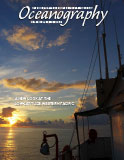Article Abstract
Located at the crossroads of the tropical and subtropical circulations, the westward-flowing North Equatorial Current (NEC) and its subsequent bifurcation off the Philippine coast near 13°N serve as important pathways for heat and water mass exchanges between the mid- and low-latitude North Pacific Ocean. Because the western Pacific warm pool, with sea surface temperatures >28°C, extends poleward of 17°N in the western North Pacific, the bifurcation and transport partitioning of the NEC into the Kuroshio and Mindanao Currents are likely to affect the temporal evolution of the warm pool through lateral advection. In addition to its influence on physical conditions, NEC variability is also important to the regional biological properties and the fisheries along the Philippine coast and in the western Pacific Ocean. This article synthesizes our current understandings of the NEC, especially those garnered through the recent Origins of the Kuroshio and Mindanao Current (OKMC) project.

